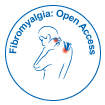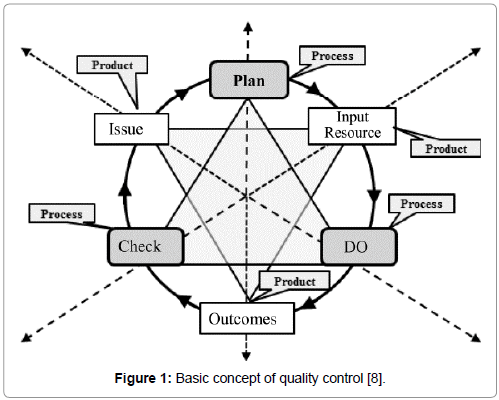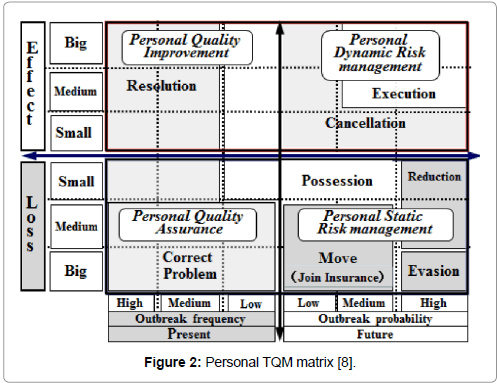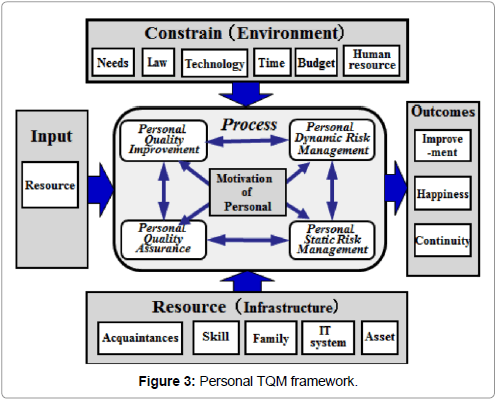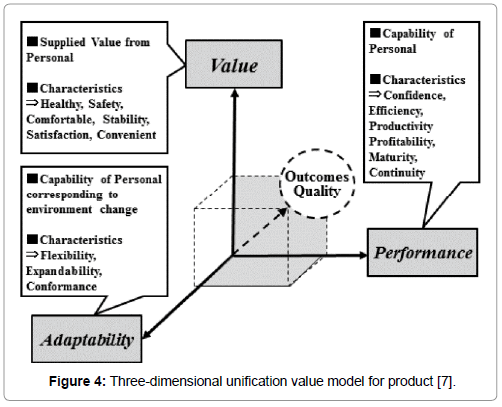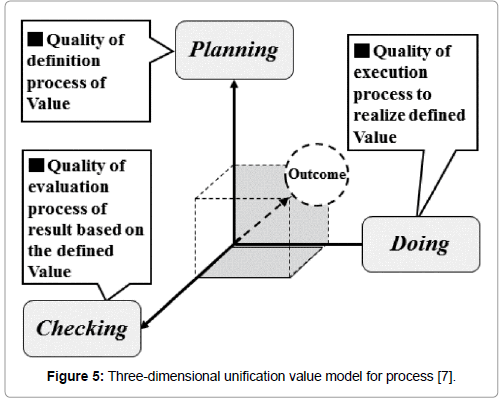Application of New TQM Techniques to Personal Life
Received: 27-Dec-2017 / Accepted Date: 01-Jan-2018 / Published Date: 07-Jan-2018
Abstract
Personal quality and total quality management (TQM) are key success factors for organization management. In our previous study, we suggested the use of three-dimensional unification value models of product and process. We also proposed the concept of a TQM matrix and developed a new general framework for TQM by integrating these concepts. Furthermore, in our previous study, we proposed the application of the framework of new TQM for improving the quality of healthcare institutions. However, person is the smallest element of an organization. Therefore, we believe that the general framework of new TQM may be applicable for improving the quality of personal management. In this article, we propose the concept of personal TQM and address the general scope of personal management for solving problems and issues related to personal life. Moreover, this paper clarifies the usefulness of this application.
Keywords: Personal quality; Personal life; Product; Process; Quality management; Quality assessment; TQM matrix; Three-dimensional unification value models; TQM framework; Healthcare of person
Introduction
The quality of person is a key factor affecting the success of organizational management. No organization can achieve its purpose without good person. On the other hand, total quality management (TQM) has grown and been defined in several organizations, and it now plays a vital role in personal management. Some viewpoints on the evaluation of personal quality for organizational reinforcement are provided in a personal checklist. The concept of a personal checklist was suggested by Harry V. Roberts, [1] professor emeritus at the University of Chicago’s Graduate School of Business, and Bernard F. Sergesketter, Vice President of the central region of AT&T, and it has been implemented by systematically keeping personal checklists for quality improvement. The relationship between this checklist and existing personal TQM techniques is discussed in a study by Rania [2]. However, these studies have only examined personal quality and nature and has not accounted for the environment surrounding a person. Considering that existing methods are accurate, it seems reasonable to assume that the same worker may be more productive in one environment than in another. On the other hand, to achieve good outcomes and performance, organizational management needs to keep workers happy and satisfied. The management must provide a better environment for daily activities if it expects person to perform well [3]. TQM is recognized and used around the world as a way to improve an organization’s management quality [4]. It is a process involving the management and employees continually finding ways to improve their products and services. It offers a combination of quality and management tools to enhance new business growth and reduce unwanted waste while aiming at increasing productivity and profits. It was developed by Deming for the U.S. industry before the Second World War. At that time, TQM was only important for the industrial sector, but now, it is employed in many business fields. It has been used by many organizations, and several empirical studies have been proposed. However, it is difficult to establish the full management scope of the TQM; nevertheless, we have developed an ISO/IEC 25000 (SQuaRE) series of standards for quality requirements and evaluation of systems and software products [5]. As part of this project, we developed the ISO/IEC 9126-1: systems and software quality models (replaced by ISO/IEC 25010, 2011) as well as the ISO/IEC 25040 and 25041 system-quality-evaluation processes [6,7]. In our previous study [8], we proposed the concept of a three-dimensional unification value model of a system product, which is integrated with the system quality model defined in ISO/IEC_9126 [9]. Here, “system” is defined as a combination of interacting elements organized to achieve one or more stated purposes, which follows the definition given by ISO/IEC15288 [10]. Based on this definition, an organization with a specific purpose is regarded as a kind of system, including person. In addition, we presented the concept of a TQM matrix [11] based on the principle of quality control and the structure of problem management. Based on the assumptions proposed in that previous study [11], we developed a new general framework for TQM based on the framework of system quality requirements and evaluation defined in ISO/IEC 25040 and 25041 as well as a TQM matrix for assessing the management quality of an organization; we investigated its effectiveness by comparing its performance with that of conventional TQM [4]. Furthermore, in another study [12], we suggested the target entities of TQM of a company based on the general framework of the new TQM and three-dimensional unification value models. Moreover, we proposed an application of the new general framework for improving the quality of healthcare institutions [13,14].
However, based on the definition of a system, a person with a specific purpose is regarded as a kind of system and small element of an organization, and the impact of an environment on a person should also be taken into account when using TQM. Therefore, in this article, we propose the concept of personal TQM by applying new TQM’s general concept to the management of personal life. This concept of personal activity is undertaken using a specially defined TQM matrix and three-dimensional unification value models of product and process. This paper also addresses the problems and issue related to personal management with the application of conventional TQM and reports the results of a validation experiment. Table 1 shows the definition and explanation of key terminologies in this article.
| Terminology | Product | Process |
|---|---|---|
| Input, Recourses, Constrains and Outcomes for Personal activities. Also inherent attribute of Personal. | Procedure or method of Personal activities. | |
| Quality: The whole of the quality of a product and process about the ability to satisfy stated or implied needs. | From ISO, terminology "Product Quality" is defined as "totality of characteristics of an entity that bear on its ability to satisfy stated and implied needs". “System product quality” is defined in six characteristics in ISO/IEC9126 (ISO/IEC25010) Quality models. | "Process quality" is the efficiency of conversion process from input resources into outcomes and that is evaluated by following equation. Process quality=Outcomes/Input -does CPD cycle rotate? -to satisfy ISO9000 requirements? |
| Primary Quality: Quality to meet specified requirements. | Quality of Outcomes meets Quality requirement specification. | An activity of Personal quality meets quality requirement specification of activity of Personal. For ex, rules of inner medical organization or international standard. |
| Secondary Quality: An expected quality of “Personal service and activity of Personal” | An attractive Personal service quality to meet a tacit expectation of customer needs. | An effective activity of Personal quality to meet a tacit expectation of stakeholders needs. |
| Problem: An abnormal status of product or process. The state that is not realizes primary quality. Problems can be zero finally if we completed a correction. | An abnormal status of product that is deviated from quality requirement specification of product. -For example, a problem of product is such as a defect, a fault, an error, an obstacle, etc. |
An abnormal status of process that is deviated from quality requirement of process. -For example, it is not to meet the process requirements of ISO9000 or rules of the inner or outer organization. |
| Issue: An expected status of product or process. The status that is not realizes second quality. An issue should be solved by considering a priority, importance, effectiveness and urgency. An issue is never disappears | An expected status of a product which want to be improved in a more attractive quality. | A prospective quality of process that want to be improved more efficiently. |
| Static Risk: Outbreak probability and the scale of the damage. | The damage that may occur in future by leaving an inner or outer problem or issue of product of Personal activity. | The damage that may occur in future by leaving an inner or outer problem or issue of process of personal activity. |
| Dynamic Risk: Outbreak probability and the scale of an effect or loss. For example, dynamic risk management is necessary for investment or project management. | An expected effect or loss that may occur in the future by a personal activity for the resolution of an inner or outer problem or issue of product. | An expected effect or loss that may occur in the future by a personal activity for the resolution of an inner or outer problem or issue of process. |
Table 1: Explanation of Terminology.
Basic Concept of Quality Control
Figure 1 shows the basic concept of quality control that is applied by the Plan–Do–Check (PDC)-cycle concept proposed in previous studies. It shows that each activity includes a product and a process. Quality control is a repetition of product and process, which is a sequence of product and process. It also shows that process quality is affected by quality of input resources, which is a result of previous management processes. Therefore, process quality depends on the quality of previous processes, which do not emerge in isolation. Regarding the above assumptions, it is important to evaluate both process and product by considering the basic concept of quality control. To improve activity in personal life, it is important to evaluate both product and process. Each personal activity is a process for converting input resources (a product) into outcomes (a product). Therefore, we can evaluate the process quality of personal activity by calculating the quality of input resources and outcomes using Equation (1):
Figure 1: Basic concept of quality control [8].
Process quality of personal activity=Outcomes/Input resources - - - - - (1)
To improve personal management, quality of target entities of both product and process should be visualized and the PDC cycle should be realized.
Concept of Personal TQM Matrix
Based on the concept of TQM matrix suggested by Esaki [11], personal TQM matrix can be explained as shown in Figure 2, which includes four target domains of process quality management.
Figure 2: Personal TQM matrix [8].
Figure 2 includes the conventional process quality management domains of quality assurance and quality improvement for personal life. It also includes additional process quality management domains such as dynamic risk management (conventional investment or project management) and static risk management (conventional risk management). A person’s problem is defined by the scale of damage and the outbreak frequency of damage at present. Thus, personal problems should be corrected as soon as possible after detection. On the other hand, an issue of personal life is defined by the scale of expected good value and an outbreak provability of expected good value at present. In contrast, static risk of personal management is defined by the scale of prospective damage and the prospective outbreak provability of damage in the future. Static risk management of personal management, such as possession, move, reduction, and evasion, should be performed by considering the results of risk analysis based on the concept of TQM matrix. Dynamic risk of personal management is defined by the scale of expected good value or damage and the expected outbreak probability in the future. Therefore, dynamic risk management of personal management, such as an investment or a project, should be performed considering risk. Also, dynamic risk management should be performed by considering the priorities, necessities, effectiveness, and limited input resources.
Framework of Personal TQM
The framework of personal TQM is defined by considering the relevant target management domains of products and process Based on the new general framework for TQM [11,12], the framework of personal TQM can be explained by Figure 3.
Target Domains of Product Quality Management
The target domains of product quality management of personal TQM are defined by considering the framework of quality requirements and evaluation of system as defined in ISO/IEC 25040 and 25041 [6,7]. Five target domains of product quality management, i.e., input resources, outcomes, constraints, supporting resources, and person themselves, are defined in the framework of personal TQM as shown in Figure 3. The domain of person themselves is located in the center of Figure 3. In contrast, domains such as input resources, outcomes, constraints, and supporting resources are located in outside of personal activity.
Person themselves
This domain is defined by the inherent attributes and assigned properties of a person. A person themselves could represent the top management, manager, worker, student, etc.
Input resources for personal activity
This domain is defined by the necessary input resources that can be taken from outside of the personal activity to achieve the objectives of personal life. These input resources include products such as equipment, tools, facilities, materials, engineering techniques and education, kind of services received.
Constraints on personal activity
This domain is defined by the limitations of products such as needs, purposes, goral, requirements, budgets, and schedules based on an outside or inside stakeholder’s needs. Moreover, constraints include limitations arising from laws, rules, standards, plans, financial resources, human resources, facilities, the environment, and technologies.
Supporting resources for personal activities
This domain is defined by the product such as the supporting practice and kind of infrastructure, such as nation, company, family, human resources, facilities, information systems, equipment, technologies, and financial resources that are held by persons.
Outcomes of personal activity
This domain includes two types of products. One product is the main results of personal activities, such as products, services, and contributions. The other product is the subsidiary results of personal activities, such as various improvements or negative effects.
Target Domains of Process Quality Management
The target domains of process quality management of personal TQM are defined by considering the TQM matrix [11]. Four target domains of process quality management, i.e., quality assurance, quality improvement, static risk management, and dynamic risk management (for example, investment management or project management), are defined in the framework of personal TQM as shown in Figure 3.
Quality assurance of personal life
This domain is an assurance activity for achieving primary quality of products or processes for personal life, such as a promised item or contract for stakeholders.
Quality improvement of personal life
This domain is an improvement activity for realizing the secondary quality of products or processes for personal life, such as a training or thinking for stakeholders.
Static risk management of personal life
This domain is the conventional risk management for personal life. Static risk is defined by the expected outbreak probability and scale of prospective damage in the future if a person’s problem is left without achieving any solutions. Persons should investigate the negative risks of products and processes of personal life based on the results of risk analysis and the need to arrive at suitable solutions as shown in Figure 2.
Dynamic risk management of personal life
This domain is a synonym for conventional investment management or project management. Dynamic risk management is performed to achieve an expected good value in the future. Dynamic risk is defined by the expected outbreak probability and scale of expected good value as well as prospective damage and outbreak probability in the future when making an investment or performing a project.
Target Entity of Personal Management
Target entities of personal management are defined by considering the viewpoint of product and process quality based on the concept of three-dimensional unification value models of product and process.
Viewpoint of Product Quality Assessment
The target entities of product quality management of personal life should correspond to each of the five quality management domains of product as shown in Figure 3. Figure 4 shows the concept of three-dimensional unification value model for product quality assessment of personal life [8]. This model defines the three characteristics, i.e., value, performance, and adaptability, for product quality assessment of personal life.
Figure 4: Three-dimensional unification value model for product [7].
Value axis
The characteristic associated with the value axis is the quality of a five kind of product domains concerning personal life which is a target value defined by the planning.
This axis represents the value of a products such as the person themselves, input resources, constraints, supporting resources and outcomes supplied by personal activities in a specific context.
Performance axis
The characteristic associated with the performance axis is the quality of a five kind of product domains concerning personal life which is a capability to achieve the defined value.
This axis represents the capability of a products such as the person themselves, input resources, constraints, supporting resources and outcomes supplied by personal activities in a specific context.
Adaptability axis
The characteristic associated with the adaptability axis is the quality of a five kind of product domains concerning personal life which is a capability to correspond a changing environment in space or in time. This axis represents the adaptability of a products such as the person themselves, input resources, constraints, supporting resources and outcomes supplied by personal activities in a specific context
In this model, these three axes correspond to the process of the PDC cycle, as shown in Figures 1 and 5. The characteristics of value and performance should be distinguished from one another.
Figure 5: Three-dimensional unification value model for process [7].
Figure 3 shows that the total quality of product quality management can be explained by the volume of the cuboids or vectors along the value, performance, and adaptability axes.
Viewpoint of Process Quality Assessment
The target entities of process quality management of personal life should correspond to each of the four quality management domains of process as shown in Figures 2 and 3. Figure 5 shows the concept of the three-dimensional unification value model for process quality assessment [12,14]. The concept of this model is constructed based on the basic concept of quality control (Figure 1) and the three-dimensional unification value model for products (Figure 4). This model defines three characteristics, i.e., planning, doing, and checking, for process quality assessment of personal life.
Planning axis
The characteristic associated with the planning axis is the quality of a four kind of process domains concerning personal life. This axis represents the quality of the planning process (i.e., the ability to make a suitable plan to achieve an ultimate value, such as a purpose, an objective, a schedule, or a budget).
Doing axis (execution)
The characteristic associated with the doing axis is the quality of a four kind of process quality domains concerning personal life. This axis represents the quality of the execution process (i.e., the productivity and efficiency of process achieving the objectives of a defined value).
Checking axis (evaluation)
The characteristic associated with the checking axis is the quality of a four kind of process quality domains concerning personal life. This axis represents the quality of the evaluation process (i.e., checking the correctness or suitability of the outcomes by comparing it to a defined plan).
The characteristics of planning and execution should be distinguished because execution is performed to achieve a plan. Planning and evaluation should be distinguished because evaluation is performed based on a plan.
Figure 5 shows that the total quality of the process quality management of personal life can be explained by the volume of the cuboids or vectors along the planning, doing, and checking axes.
Target Entities of Product Quality Management for Personal Life
Table 2 shows the examples of concrete target entities of product quality management for personal life from the viewpoint of three-dimensional unification value models of products in the five product quality management domains of personal TQM. Table 2 allows us to confirm the existence of concrete target domains of product quality management, such as outcomes, input resources, constraints, and supporting resources. Furthermore, the existence of concrete target entities of product quality assessment for value, performance, and adaptability can be confirmed for product quality assessment in the five product quality management domains. Therefore, our scheme appears useful for the product quality management of personal life. All target entities in Table 2 should be controlled from the perspective of the product quality management domains for enhanced product quality.
| Framework of personal TQM | Criteria of Personal Management | |||||||||||
|---|---|---|---|---|---|---|---|---|---|---|---|---|
| Target Domains | Target Entities | |||||||||||
| View point of system quality evaluation | View point of TQM matrices |
View point of Three Dimensional Unification Value Models |
||||||||||
| Product | Process | Product | Process | |||||||||
| Assurance | Improvement | Static Risk | Dynamic Risk | Value | Performance | Adaptability | Planning | Doing | Checking | Definition | Example of Target Entities of Product | |
| Person Character | ● | Mind, Spirit -Capability -Adaptability to correspond environmental change |
⇒ Ethic, Fairness, Good sense of responsibility ⇒ Decision making, Leadership, Strategy control ⇒ Political Skill, Technical Skill, Ability for self ⇒ A future flexibility, Accountability Communication, Expandability-act |
|||||||||
| ● | ||||||||||||
| ● | ||||||||||||
| Input: for Personal activity | ● | Value of input resources -Capability of input resources -Adaptability of input resources |
⇒ Safe food, Water, Air, Taste, a look, the freshness, a fragrance, pleasure, comfort, Superior medical equipment, Medicine, Sickbed, Facility, IT System Intelligence, education, contents, media ⇒ Human Resource ( Doctor, Nurse, Personal, Teacher, Worker) , Education, Service, Facility, IT System, Equipment ⇒ Flexibility, future expandability and conformance of input product (resources) |
|||||||||
| ● | ||||||||||||
| ● | ||||||||||||
| Outcomes: of personal activity |
● | Value of outcomes -Result of improvement concerning Personal -Capability of outcome -Result of improvement of capability -Adaptability of outcomes -Result of improvement of adaptability |
⇒ Satisfaction of Personal and Worker ⇒ Health body, Good mind, Contribution, Effect, Safely, Relief, Happiness, Pleasure, Comfort ⇒ Safety food, Water, Air, Taste, A look, the freshness, A fragrance, A quality ⇒ Good Service, Skill, Facility, Equipment, Technology, Waiting time, Cost reduction, Performance, Confidence, Productivity, Effectiveness ⇒ Flexibility, future expandability and conformance of output product (concerning personal ) |
|||||||||
| ● | ||||||||||||
| ● | ||||||||||||
| Constrains of Personal from an inside or outside environment |
● | Constrain from a strategy and rule -Constrain from Needs -Constrain of Schedule & Budget -Limitation of capability of resources -Limitation of adaptability of resources |
⇒Law necessary for personal life, ⇒Human resource, Budget, Time schedule, An education system, A change of a personal environment, Expenses, Supporting technology, Superior equipment, Education ⇒Limitation of personal expenses, technology, supporting system, ability of Personal skill ⇒Using technology, Supporting system, Education ⇒Flexibility, A future expandability of product |
|||||||||
| ● | ||||||||||||
| ● | ||||||||||||
| Resources: Supporting infrastructure of Personal for personal activity | ● | Value of holding resources of Personal -Capability of holding resources of Personal -Adaptability of holding resources of Personal |
⇒ Value of asset, using system, House, facilities ⇒ Value of Supporting technology, Equipment, Knowledge data base ⇒ Family, Friend, Asset, Supporting technology, Superior equipment, facilities, IT system, Education system ⇒ Technology, Supporting system, Education system ⇒ Flexibility, A future expandability of product |
|||||||||
| ● | ||||||||||||
| ● | ||||||||||||
●:This mark is the view point of management
Table 2: Target Entities of Product-Quality management of Personal-Life
Target Entities of Process Quality Management for Personal Life
Table 3 shows the examples of concrete target entities of process quality management for personal life from the viewpoint of threedimensional unification value models of processes in the four process quality management domains of personal TQM. Table 3 allows us to confirm the existence of both concrete conventional (e.g., quality assurance and quality improvement) and unconventional (e.g., static risk management and dynamic risk management) target domains of process quality management. Furthermore, the existence of concrete target entities of personal life for planning, doing, and checking for the process quality assessment of each of the four process quality management domains can also be confirmed. Therefore, our proposed scheme is applicable to all aspects of the process quality management for personal life. All target entities in Table 3 should be controlled from the perspective of the process quality management domains for enhanced effectiveness, productivity, and to avoid damage.
| Framework of personal TQM | Criteria of Personal Management | ||||||||||||
|---|---|---|---|---|---|---|---|---|---|---|---|---|---|
| Target Domains | Target Entities | ||||||||||||
| View point of TQM matrices | View point of system quality evaluation | View point of Three Dimensional Unification Value Models |
|||||||||||
| Process | Product | Product | Process | ||||||||||
| Personal | Input | Constrain | Resource | Outcomes | Value | Performance | Adaptability | Planning | Doing | Checking | Definition | Example of Target Entities of Product | |
| Quality Assurance |
● | An activity of assurance to achieve a Primary Quality of Product or Process of Person |
Planning Process of quality assurance for Personal | ||||||||||
| ● | Execution Process of quality assurance for Personal | ||||||||||||
| ● | Checking Process of quality assurance for Personal | ||||||||||||
| Quality Improvement |
● | An activity of improvement to realize Secondary Quality of Product or Process for Personal |
Planning Process of quality improvement for Personal | ||||||||||
| ● | Execution Process of quality improvement for Personal | ||||||||||||
| ● | Checking Process of quality improvement for Personal | ||||||||||||
| Static Risk Management |
● | An activity to keep Primary Quality of Product or Process for Personal in future |
Planning Process of static risk management for Personal | ||||||||||
| ● | Execution Process of static risk management for Personal | ||||||||||||
| ● | Checking Process of static risk management for Personal | ||||||||||||
| Dynamic Risk Management |
● | An activity to realize Secondary Quality of Product or Process for Personal in future. An activity to realize Secondary Quality of Product or Process for Personal in future |
Planning Process of dynamic risk management for Personal | ||||||||||
| ● | Execution Process of dynamic risk management for Personal | ||||||||||||
| ● | Checking Process of dynamic risk management | ||||||||||||
●:This mark is the view point of management
Table 3: Target Entities of Process-Quality management of Personal-Life
Discussion
From Figure 1, personal activity is the process of converting input resources into outcomes as defined in the framework of personal TQM. Therefore, it is important to improve product quality of personal quality management and to obtain best outcomes from limited input resources. To improve quality of personal life, it may be necessary to improve the quality of the target entities of both products and processes as shown in Tables 2 and 3. Therefore, the target entities of product quality management domains such as the person themselves, input resources, constants, and supporting resources, are important for improving the outcomes included in Table 2. Also, to assess product quality management of personal life, the quality of concrete target entities of product in Table 2 should be considered in terms of characteristics such as value, performance, and adaptability. From Table 2, value is considered the most important product quality characteristic for product quality assessment of personal life during the planning process. Because an excellent value of personal life cannot be achieved by an excellent performance of person usually. Therefore, to assess product quality of personal life, we distinguish value from performance to avoid misrepresenting a purpose as a means.
On the other hand, for improvement of process quality of personal life, we should assess the quality of the concrete target entities of process quality domains, such as the perspectives of conventional quality assurance and quality improvement, as well as static and dynamic risk management, as shown in Table 3.
To assess the productivity of process quality management for personal life, the quality of the concrete target entities of process in Table 3 should be considered in terms of characteristics such as planning, doing, and checking. From Table 3, planning is considered the most important process quality characteristic for the process quality assessment of the total life cycle process of personal life because high quality planning of personal life may achieve high quality outcomes of execution. If we do not make plans, we cannot evaluate the outcomes of evaluation because outcomes can only be evaluated by objectives defined in planning. Therefore, to assess process quality of personal life, we should evaluate not only process quality of personal life but also product quality such as input product quality of planning and outcomes product quality of execution as shown in Table 2. Also it is important to circulate positive PDC cycle effectively.
Conclusion
In this article, we presented a scheme for the total quality management of personal life by applying our previously proposed framework of new TQM for organizations. This study has contributed the concept of basic quality control, three-dimensional unification value models of product and process, personal TQM matrix, and the concept of personal TQM for quality management of personal life. We have also presented and verified the scope and concrete target entities of total quality management of personal life through personal TQM.
In the future, we would like to experimentally investigate the application of personal TQM to personal life. In addition, the success factors of personal life should be quantitatively analyzed in depth based on the concept of personal TQM. Furthermore, useful methods for assessing and improving quality management of personal life should be developed.
References
- American Malcolm Baldridge (2014) Criteria for Performance Excellence programme 2017-2018.
- ISO/IEC25040 (2011) Software engineering-System and software Quality Requirements and Evaluation (SQuaRE)-Evaluation process.
- ISO/IEC25041 (2012) Software engineering-System and software Quality Requirements and Evaluation (SQuaRE)-Evaluation guide for developers, acquirers and independent evaluators.
- ISO/IEC9126-1 (2001) Software engineering-Product-quality-Part1: Quality model.
- Rania K (2014) Personal quality and TQM the use of personal checklists to facilitate TQM. ESJ 1: 54-59.
- Roberts H, Sergesketter B (1993) Quality is personal: A foundation for total quality management. New York: Free Press.
- Esaki K (2013a) Three dimensional integrated value models based on ISO/IEC9126 system quality model. AJOR 3: 342–349.
- Esaki K (2013b) General frame work of new TQM based on the ISO/IEC25000 series of standard. Intell Inf Manag 5: 126–135.
- Esaki K (2015) Target entities of total quality management based on the new TQM and three-dimensional unification value models. Intell Inf Manag 7: 70–79.
- Esaki K (2016a) Application of framework of new TQM to healthcare. J Nurs Healthcare 1: 1–8.
- Esaki K (2016b) Common management process of new TQM based on the situation analysis. Intelligent Information Management 8: 181–193.
- ISO/IEC15288 (2015) Systems and software engineering-System life cycle process, Int’l Organisation for Standardization.
- ISO/IEC25000 (2014) System and software engineering-System and software Quality Requirements and Evaluation (SQuaRE)-Guide to SQuaRE, Int’l Organization for Standardization.
Citation: Esaki K (2018) Application of New TQM Techniques to Personal Life. Fibrom Open Access 3: 127.
Copyright: ©2018 Esaki K. This is an open-access article distributed under the terms of the Creative Commons Attribution License, which permits unrestricted use, distribution, and reproduction in any medium, provided the original author and source are credited.
Select your language of interest to view the total content in your interested language
Share This Article
Open Access Journals
Article Usage
- Total views: 8554
- [From(publication date): 0-2018 - Jun 29, 2025]
- Breakdown by view type
- HTML page views: 7470
- PDF downloads: 1084
